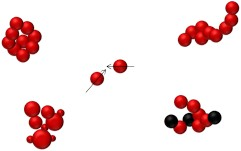Atmospheric particle size and number change calculations
Airborne particles may collide with each other and form agglomerates in a process called coagulation. Coagulation reduces the particle number concentration, whereas the mass concentration remains unaffected. Furthermore, coagulation of particles increases the mean particle size. Both of these changes can easily be estimated using deterministic equations.
|
(1) (2) (3)
|
\(k_{straining}\) is the straining rate constant and \(\Psi\) is the depth-dependent straining rate coefficient. \(k\) expresses the pseudo-first order rate of the interaction itself. This coefficient depends on the distance \(z\) from the origin/injection point of the nanomaterials in the porous medium and also on the average aggregate (collector) diameter \(d_{50}\). \(\beta\) is an empirical factor expressing the intensity of this depth dependence. The change in the number concentration N(t) and the particle size dp over time t can be calculated by equations (1) and (3). N0 is the initial number concentration, dp,0 the initial particle diameter and K the coagulation coefficient, given in equation (2), which is a function of the particle diameter dp and the particles diffusion coefficient D. Strictly, these equations are only applicable to coalescing droplets, but they also provide a good estimate for the effect of coagulation on solid particles. |
Execution |
|
|
These equations are purely deterministic and can easily be solved using a pocket calculator or spreadsheet software. |
Used in |
|
|
|
Read more |
Read also |
|
|
W. Hinds (1999): Aerosol Technology – Properties, Behavior, and Measurement of Airborne Particles, John Wiley & Sons.
|
Contact

Christof Asbach
Institut für Energie- und Umwelttechnik (IUTA)
Email: asbach@iuta.de

